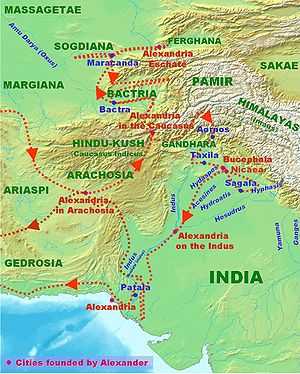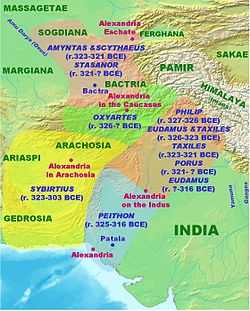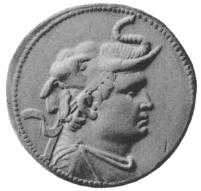Greek conquests in India
In ancient times, trade between the Indian subcontinent and Greece flourished with silk, spices and gold being traded. The Greeks invaded India several times, starting with the conquest of Alexander the Great.
Conquests of Alexander The Great (327–326 BC)

In 327 BC Alexander the Great began his foray into Punjab. King Ambhi, ruler of Taxila, surrendered the city to Alexander. Many people had fled to a high fortress/rock called Aornos. Aornos was taken by Alexander by storm after a successful siege. Alexander fought an epic battle against the Indian monarch Porus in the Battle of Hydaspes (326). After victory, Alexander made an alliance with Porus and appointed him as satrap of his own kingdom. Alexander continued to conquer all the headwaters of the Indus River.
East of Porus' kingdom, near the Ganges River, was the powerful kingdom of Magadha, under the Nanda Dynasty.
According to Plutarch, at the time of Alexander's Battle of the Hydaspes River, the size of the Magadha's army further east numbered 200,000 infantry, 80,000 cavalry, 8,000 chariots, and 6,000 war elephants, which was discouraging for Alexander's men and stayed their further progress into India:
| “ | As for the Macedonians, however, their struggle with Porus blunted their courage and stayed their further advance into India. For having had all they could do to repulse an enemy who mustered only twenty thousand infantry and two thousand horse, they violently opposed Alexander when he insisted on crossing the river Ganges also, the width of which, as they learned, was •thirty-two furlongs, its depth •a hundred fathoms, while its banks on the further side were covered with multitudes of men-at‑arms and horsemen and elephants. For they were told that the kings of the Ganderites and Praesii were awaiting them with eighty thousand horsemen, two hundred thousand footmen, eight thousand chariots, and six thousand fighting elephants. And there was no boasting in these reports. For Androcottus, who reigned there not long afterwards, made a present to Seleucus of five hundred elephants, and with an army of six hundred thousand men overran and subdued all India. | ” |
--Plutarch, Parallel Lives, "Life of Alexander"
Exhausted and frightened by the prospect of facing another giant Indian army at the Ganges River, his army mutinied at the Hyphasis (modern Beas), refusing to march further East. Alexander, after the meeting with his officer Coenus, was convinced that it was better to return.
Alexander was forced to turn south, conquering his way down the Indus to the Arabian Sea. He sent much of his army to Carmania (modern southern Iran) with his general Craterus, and commissioned a fleet to explore the Persian Gulf shore under his admiral Nearchus, while he led the rest of his forces back to Persia by the southern route through the Gedrosia (modern Makran in southern Pakistan).

Alexander left behind Greek forces which established themselves in the city of Taxila, now in Pakistan. Several generals, such as Eudemus and Peithon governed the newly established province until around 316 BC. One of them, Sophytes (305–294 BC), was an independent Greek prince in the Punjab.
Seleucid Invasion (305 BC)
Seleucus I Nicator, founder of the Seleucid dynasty and one of Alexander's former generals, invaded what is now Punjab in northern India and Pakistan) in 305 BC.[1]
Details of Seleucus's conflict with Chandragupta Maurya are unknown but Chandragupta seems have had the best of it. Chandragupta and Seleucus finally concluded an alliance. Seleucus gave him his daughter in marriage, ceded the territories of Arachosia, and received from Chandraguta 500 war elephant which he used decisively at the Battle of Ipsus.[1]
Seleucus also sent an ambassador named Megasthenes to Chandragupta's court, who repeatedly visited Chandragupta's capital of Pataliputra (modern Patna in Bihar state). Megasthenes wrote detailed descriptions of India and Chandragupta's reign.
Continued diplomatic exchanges and good relations are between the Seleucids and the Mauryan emperors are then documented throughout the duration of the Mauryan empire.
Indo-Greek rule (180 BC-10 AD)


In 180 BC, the Indo-Greeks, invaded parts of northwest and northern India and ruled in the Punjab region. They are an extension of the Greco-Bactrian dynasty of Greek kings (the Euthydemids) located in neighbouring Bactria.
The invasion of northern India followed the destruction of the Mauryan dynasty by the general Pushyamitra Sunga, who then founded the new Indian Sunga dynasty (185 BC-78 BC). The Indo-Greek king Menander may have campaigned as far as the capital Pataliputra in eastern India (today Patna): "Those who came after Alexander went to the Ganges and Pataliputra" (Strabo, XV.698). An Indian text describes Greek attacks on Saketa, Panchala, Mathura and Pataliputra (Gargi-Samhita, Yuga Purana chapter).
The Indo-Greeks ruled various parts of northwestern India until the end of the 1st century BC, when they were conquered by the Scythians and Kushans.
Legacy
Buddhism flourished under the Indo-Greeks, leading to the Greco-Buddhist cultural syncretism. The arts of the Indian sub-continent were also quite affected by Hellenistic art during and after these interactions.
References
| Middle kingdoms of India | ||||||
|---|---|---|---|---|---|---|
| Timeline and cultural period |
Northwestern India (Punjab-Sapta Sindhu) |
Indo-Gangetic Plain | Central India | Southern India | ||
| Western Gangetic Plain | Northern India (Central Gangetic Plain) |
Northeastern India | ||||
| IRON AGE | ||||||
| Culture | Late Vedic Period | Late Vedic Period (Brahmin ideology)[lower-alpha 1] |
Late Vedic Period (Kshatriya/Shramanic culture)[lower-alpha 2] |
Pre-history | ||
| 6th century BCE | Gandhara | Kuru-Panchala | Magadha | Adivasi (tribes) | ||
| Culture | Persian-Greek influences | "Second Urbanisation" Rise of Shramana movements |
Pre-history | |||
| 5th century BCE | (Persian rule) | Shishunaga dynasty | Adivasi (tribes) | |||
| 4th century BCE | (Greek conquests) |
Nanda empire |
||||
| HISTORICAL AGE | ||||||
| Culture | Spread of Buddhism | Pre-history | Sangam period (300 BCE – 200 CE) | |||
| 3rd century BCE | Maurya Empire | Early Cholas Cheras 46 other small kingdoms in Ancient Thamizhagam | ||||
| Culture | Preclassical Hinduism[lower-alpha 3] - "Hindu Synthesis"[lower-alpha 4] (ca. 200 BCE - 300 CE)[lower-alpha 5][lower-alpha 6] Epics - Puranas - Ramayana - Mahabharata - Bhagavad Gita - Brahma Sutras - Smarta Tradition Mahayana Buddhism |
Sangam period (continued) | ||||
| 2nd century BCE | Indo-Greek Kingdom | Sunga Empire | Adivasi (tribes) | Early Cholas Cheras 46 other small kingdoms in Ancient Thamizhagam | ||
| 1st century BCE | Yona | Maha-Meghavahana Dynasty | ||||
| 1st century CE | Kuninda Kingdom | |||||
| 2nd century | Pahlava | Varman dynasty | ||||
| 3rd century | Kushan Empire | Western Satraps | Kamarupa kingdom | Kalabhras dynasty Pandyan Kingdom(Under Kalabhras) | ||
| Culture | "Golden Age of Hinduism"(ca. CE 320-650)[lower-alpha 7] Puranas Co-existence of Hinduism and Buddhism | |||||
| 4th century | Gupta Empire | Kalabhras dynasty Pandyan Kingdom(Under Kalabhras) Kadamba Dynasty Western Ganga Dynasty | ||||
| 5th century | Maitraka | Adivasi (tribes) | Kalabhras dynasty Pandyan Kingdom(Under Kalabhras) | |||
| 6th century | Kalabhras dynasty Pandyan Kingdom(Under Kalabhras) | |||||
| Culture | Late-Classical Hinduism (ca. CE 650-1100)[lower-alpha 8] Advaita Vedanta - Tantra Decline of Buddhism in India | |||||
| 7th century | Indo-Sassanids | Vakataka dynasty, Harsha | Mlechchha dynasty | Adivasi (tribes) | Pandyan Kingdom(Under Kalabhras) Pandyan Kingdom(Revival) | |
| 8th century | Kidarite Kingdom | Pandyan Kingdom Kalachuri | ||||
| 9th century | Indo-Hephthalites (Huna) | Gurjara-Pratihara | Pandyan Kingdom Pandyan Kingdom(Under Cholas) Chera Perumals of Makkotai | |||
| 10th century | Pala dynasty Kamboja-Pala dynasty |
Medieval Cholas Pandyan Kingdom(Under Cholas) Chera Perumals of Makkotai Rashtrakuta | ||||
References and sources for table References Sources
| ||||||